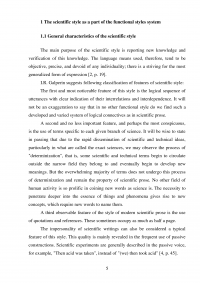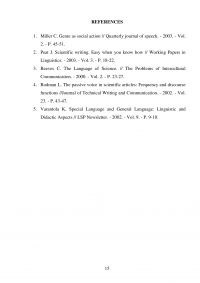Scientific style: substyles, genres and distinctive features
| Код | 234656 | ||||
| Дата создания | 2016 | ||||
| Страниц | 15 ( 14 шрифт, полуторный интервал ) | ||||
| Источников | 5 | ||||
|
Файлы
|
|||||
|
Без ожидания: файлы доступны для скачивания сразу после оплаты.
Ручная проверка: файлы открываются и полностью соответствуют описанию. Документ оформлен в соответствии с требованиями ГОСТ.
|
|||||
Образцы страниц развернуть (15)
Описание
Содержание
Введение
The purpose of science as one of the areas of human activity is research of the nature of things and phenomena of objective reality, description of the laws governing the processes of their interaction that allows a person to control them, as well as use them to improve conditions of life.
The scientific style is widely spread in academic articles, manuals, popular science books and other scientific and academic publications. In today's world, the pace of development of science and technology has been becoming more and more dynamic, almost every day new inventions arise, which go beyond scientific and academic communities rather quickly, and come into everyday life. Undoubtedly, all of these changes have an effect on the language. Moreover, the need for communication in the field of science and technology has led to the development of a separate functional style – the scientific style, which is characterized by a number of features. The language of scientific style tends to be objective, precise and emotionless.
...
Целью науки, как одной из областей человеческой деятельности, является исследование природы вещей и явлений объективной действительности, она описывает законы, регулирующие процессы их взаимодействия, что позволяет человеку управлять ими, а также использовать их для улучшения условий жизни.
Научный стиль широко распространен в научных статьях, учебных пособиях, научно-популярных книгах и других научных и академических изданиях. В современном мире, темпы развития науки и техники становятся все более и более динамичными, почти каждый день возникают новые изобретения, которые довольно быстро выходят за рамки научных и академических кругов, появляясь в нашей повседневной жизни. Несомненно, все эти изменения оказывают влияние на язык. Более того, потребность в коммуникации в области науки и техники привела к развитию отдельного функционального стиля - научного стиля, который характеризуется рядом особенностей. Язык научного стиля, как правило, должен быть объективным, точным и неэмоциональным.
...
Фрагмент работы для ознакомления
1.1 General characteristics of the scientific style
The main purpose of the scientific style is reporting new knowledge and verification of this knowledge. The language means used, therefore, tend to be objective, precise, and devoid of any individuality; there is a striving for the most generalized form of expression [2, p. 19].
I.R. Galperin suggests following classification of features of scientific style:
The first and most noticeable feature of this style is the logical sequence of utterances with clear indication of their interrelations and interdependence. It will not be an exaggeration to say that in no other functional style do we find such a developed and varied system of logical connectives as in scientific prose.
...
2.1 The language features of the scientific style
It is easy to notice that the language of science is very different from the language of political campaigns or the language of advertising or poetry. Scientists try to find the most efficient and objective language to characterize the appearance, function or composition of phenomena.
As noted above, the main function of the scientific style is to provide the transmission of factual information, which must be clear, accurate and unambiguous. In the scientific style there is no place for repetitive and subjective information.
On this basis, it is possible to identify the common features of the scientific style:
...
2.3 Morphological level
At the morphological level the scientific style is characterized by the following features:
- Nominative character of statements which means the predominance of the noun over the verb;
...
Conclusion
The scientific style is employed in professional communication. Its most conspicuous feature is the abundance of terms that refer to objects, phenomena, processes studied in a particular branch of science or technology. The scientific style is also known for its precision, clarity and logical cohesion, which, among other things, explains the abundant use of special clichés and other lexico-syntactic means of emphasizing logical connection and interdependence of consecutive parts in scientific discourse.
The scientific style has a number of specific features which appear regardless of the area of knowledge of a particular text.
...
Список литературы [ всего 5]
- Miller C. Genre as social action // Quarterly journal of speech. - 2003. - Vol. 2. - P. 45-51.
- Peat J. Scientific writing. Easy when you know how // Working Papers in Linguistics. - 2003. - Vol. 3. - P. 18-22.
- Reeves C. The Language of Science. // The Problems of Intercultural Communication. - 2000. - Vol. 2. - P. 23-27.
- ...














